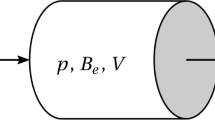Abstract
The presence of different time scales in a dynamic model significantly hampers the efficiency of its simulation. In multibody systems the fact is particularly relevant, as the mentioned time scales may be very different, due, for example, to the coexistence of mechanical components controled by electronic drive units, and may also appear in conjunction with significant nonlinearities. This paper proposes a systematic technique, based on the principles of dynamic decoupling, to partition a model based on the time scales that are relevant for the particular simulation studies to be performed and as transparently as possible for the user. In accordance with said purpose, peculiar to the technique is its neat separation into two parts: a structural analysis of the model, which is general with respect to any possible simulation scenario, and a subsequent decoupled integration, which can conversely be (easily) tailored to the study at hand. Also, since the technique does not aim at reducing but rather at partitioning the model, the state space and the physical interpretation of the dynamic variables are inherently preserved. Moreover, the proposed analysis allows us to define some novel indices relative to the separability of the system, thereby extending the idea of “stiffness” in a way that is particularly keen to its use for the improvement of simulation efficiency, be the envisaged integration scheme monolithic, parallel, or even based on cosimulation. Finally, thanks to the way the analysis phase is conceived, the technique is naturally applicable to both linear and nonlinear models. The paper contains a methodological presentation of the proposed technique, which is related to alternatives available in the literature so as to evidence the peculiarities just sketched, and some application examples illustrating the achieved advantages and motivating the major design choice from an operational viewpoint.
















Similar content being viewed by others
Notes
It is known that any multistep method can be reduced to a single-step method with an increased state space vector. Thus, in this paper we focus only on the case of single-step methods without loss of generality.
References
Antoulas, A.: Approximation of Large-Scale Dynamical Systems, vol. 6. SIAM, Philadelphia (2005)
Arnold, M., Schiehlen, W.O.: Simulation Techniques for Applied Dynamics, vol. 507. Springer, Berlin (2009)
Bartolini, A., Leva, A., Maffezzoni, C.: A process simulation environment based on visual programming and dynamic decoupling. Simulation 71(3), 183–193 (1998)
Blochwitz, T., Otter, M., Åkesson, J., Arnold, M., Clauß, C., Elmqvist, H., Friedrich, M., Junghanns, A., Mauss, J., Neumerkel, D., Olsson, H., Viel, A.: Functional mockup interface 2.0: the standard for tool independent exchange of simulation models. In: 9th International Modelica Conference, Münich, Germany, pp. 173–184 (2012). doi:10.3384/ecp12076173
Casella, F.: A strategy for parallel simulation of declarative object-oriented models of generalized physical networks. In: 5th International Workshop on Equation-Based Object-Oriented Modeling Languages and Tools, pp. 45–51 (2013)
Cellier, F., Kofman, E.: Continuous System Simulation. Springer, Berlin (2006)
Chen, J., Kang, S.M.: Model-order reduction of nonlinear MEMS devices through arclength-based Karhunen-Loeve decomposition. In: The 2001 IEEE Int. Symposium on Circuits and Systems. ISCAS 2001, vol. 3, pp. 457–460 (2001). doi:10.1109/ISCAS.2001.921346
Chen, J., Kang, S.M., Zou, J., Liu, C., Schutt-Aine, J.: Reduced-order modeling of weakly nonlinear MEMS devices with Taylor-series expansion and Arnoldi approach. J. Microelectromech. Syst. 13(3), 441–451 (2004). doi:10.1109/JMEMS.2004.828704
Goldberg, L., Ann, G.: Efficient Algorithms for Listing Combinatorial Structures, vol. 5. Cambridge University Press, Cambridge (2009)
González, F., Naya, M.Á., Luaces, A., González, M.: On the effect of multirate co-simulation techniques in the efficiency and accuracy of multibody system dynamics. Multibody Syst. Dyn. 25(4), 461–483 (2011). doi:10.1007/s11044-010-9234-7
Gu, C.: Model order reduction of nonlinear dynamical systems. Ph.D. thesis, University of California, Berkeley (2011)
Innocent, M., Wambacq, P., Donnay, S., Tilmans, H., Sansen, W., De Man, H.: An analytic Volterra-series-based model for a MEMS variable capacitor. IEEE Trans. Comput.-Aided Des. Integr. Circuits Syst. 22(2), 124–131 (2003). doi:10.1109/TCAD.2002.806603
Johnson, D.: Finding all the elementary circuits of a directed graph. SIAM J. Comput. 4(1), 77–84 (1975)
Kuznetsov, Y.: Elements of Applied Bifurcation Theory. Applied Mathematical Sciences, vol. 112. Springer, Berlin (2004)
Lall, S., Marsden, J., Glavaski, S.: A subspace approach to balanced truncation for model reduction of nonlinear control systems. Int. J. Robust Nonlinear Control 12, 519–535 (2002)
Mikelsons, L., Brandt, T.: Symbolic model reduction for interval-valued scenarios. In: ASME Conf. Proc., ASME, vol. 49002, pp. 263–272. (2009). doi:10.1115/DETC2009-86954
Mikelsons, L., Brandt, T.: Generation of continuously adjustable vehicle models using symbolic reduction methods. Multibody Syst. Dyn. 26, 153–173 (2011)
Papadopoulos, A.V., Leva, A.: Automating dynamic decoupling in object-oriented modelling and simulation tools. In: 5th International Workshop on Equation-Based Object-Oriented Modeling Languages and Tools, pp. 37–44 (2013)
Papadopoulos, A.V., Åkesson, J., Casella, F., Leva, A.: Automatic partitioning and simulation of weakly coupled systems. In: 2013 IEEE 52nd Annual Conference on Decision and Control (CDC), pp. 3172–3177 (2013)
Phillips, J.R.: Projection frameworks for model reduction of weakly nonlinear systems. In: Proc. of the 37th Annual Design Automation Conf., DAC’00, pp. 184–189. ACM, New York (2000). doi:10.1145/337292.337380
Scherpen, J.: Balancing for nonlinear systems. Syst. Control Lett. 21(2), 143–153 (1993)
Schiela, A., Olsson, H.: Mixed-mode integration for real-time simulation. In: Modelica Workshop 2000 Proceedings, pp. 69–75 (2000)
Sjölund, M.: TLM and parallelization. Technical report, Linköping University (2012)
Sjölund, M., Braun, R., Fritzson, P., Krus, P.: Towards efficient distributed simulation in Modelica using transmission line modeling. In: 3rd Int. Workshop on Equation-Based Object-Oriented Modeling Languages and Tools, pp. 71–80 (2010)
Tarjan, R.: Depth-first search and linear graph algorithms. SIAM J. Comput. 1(2), 146–160 (1971)
Tarjan, R.: Enumeration of the elementary circuits of a directed graph. SIAM J. Comput. 2(3), 211–216 (1972)
Wolf, A., Swift, J.B., Swinney, H.L., Vastano, J.A.: Determining Lyapunov exponents from a time series. Phys. D, Nonlinear Phenom. 16(3), 285–317 (1985). doi:10.1016/0167-2789(85)90011-9
Author information
Authors and Affiliations
Corresponding author
Rights and permissions
About this article
Cite this article
Papadopoulos, A.V., Leva, A. A model partitioning method based on dynamic decoupling for the efficient simulation of multibody systems. Multibody Syst Dyn 34, 163–190 (2015). https://doi.org/10.1007/s11044-014-9415-x
Received:
Accepted:
Published:
Issue Date:
DOI: https://doi.org/10.1007/s11044-014-9415-x




